Even highly successful companies see at some point the need to go beyond, expand their horizons and test if those same products which proved to be successful in their local markets can also do it again far away from home in new, bigger and unknown markets. It is then when companies see themselves confronted with some urgent questions: which markets should I enter into? Which resources (budget, personnel, infrastructure, etc.) should I invest to achieve it? Are my current assets and know-how the right ones to be able to succeed in those new markets? And finally the big final question arises: what strategy should I use?
As the reader will have probably figured out by now, there is no fix answers to those questions and as it often happens in business, the environment, structure of the company, its culture or go-to-market approach will plat a key role in the final results. In this assignment our goal will be the description, discussion and critical analysis of a successful case which, due to the origin of our company and the sector in which it operates, shows how family-owned medium-seized companies can also become industry leaders using global strategies based on exactly the same factors which made them successful in their own local market.
Inhaltsverzeichnis (Table of Contents)
- I. Executive Summary
- II. Table of Contents
- III. Table of Abbreviations
- IV. Table of Figures
- 1. Introduction
- 2. Problem definition and objectives
- 3. Micro Environment (Porter's 5 Forces)
- 3.1 Rivalry among existing competitors
- 3.2 Bargaining power of suppliers
- 3.3 Bargaining power of buyers
- 3.4 Threat of new entrants
- 3.5 Threat of substitutes
- 4. Macro Environment
- 4.1 Political
- 4.2 Economic
- 4.3 Social
- 4.4 Technological
- 4.5 Environmental
- 4.6 Legal
- 5. Main competitive advantage
- 6. Internal Analysis
- 6.1 Strengths
- 6.2 Weaknesses
- 7. External Analysis
- 7.1 Opportunities
- 7.2 Threats
- 8. International distribution channels
- 9. Strategy execution
- 10. Conclusion
- 11. References
- 12. Internet References
Zielsetzung und Themenschwerpunkte (Objectives and Key Themes)
This assignment focuses on the analysis of a successful case study demonstrating how a family-owned SME, Sennheiser, achieved industry leadership through global strategies. The goal is to understand how the company leveraged its local market success to achieve global dominance, highlighting the key factors and strategies employed.
- Exploring the strategic challenges faced by companies seeking international expansion
- Analyzing the key factors contributing to Sennheiser's success in its local market
- Identifying and evaluating the global strategies employed by Sennheiser
- Examining the role of Porter's Five Forces in shaping Sennheiser's competitive landscape
- Analyzing the internal and external factors impacting Sennheiser's international success
Zusammenfassung der Kapitel (Chapter Summaries)
- Introduction: This chapter provides an overview of the case study, introducing Sennheiser and its journey from local success to global dominance.
- Problem definition and objectives: This chapter outlines the key questions and objectives that the case study seeks to address, such as identifying Sennheiser's global expansion strategies and analyzing their impact on its success.
- Micro Environment (Porter's 5 Forces): This chapter analyzes the competitive landscape within the industry, examining the five forces that impact Sennheiser's business environment, including rivalry among existing competitors, bargaining power of suppliers and buyers, threat of new entrants, and threat of substitutes.
- Macro Environment: This chapter analyzes the broader external factors impacting Sennheiser's operations, including political, economic, social, technological, environmental, and legal influences.
- Main competitive advantage: This chapter explores Sennheiser's core strengths and unique selling propositions that contribute to its competitive edge in the global market.
- Internal Analysis: This chapter examines Sennheiser's internal strengths and weaknesses, identifying areas for improvement and leveraging its internal resources to support its global strategy.
- External Analysis: This chapter evaluates Sennheiser's external opportunities and threats, analyzing market trends, competitor activity, and emerging challenges.
- International distribution channels: This chapter examines the distribution strategies employed by Sennheiser to reach its global customer base, evaluating the effectiveness of its chosen channels.
- Strategy execution: This chapter discusses the implementation of Sennheiser's global strategies, analyzing the practical steps taken to achieve its international goals.
Schlüsselwörter (Keywords)
The core concepts and key themes explored in this case study include: global expansion strategies, SME success, industry leadership, international business, competitive advantage, Porter's Five Forces, micro and macro environment, internal and external analysis, distribution channels, and strategy execution.
- Quote paper
- Santiago Mas (Author), 2017, Successful Global Sales Strategies in SME, Munich, GRIN Verlag, https://www.grin.com/document/437673



